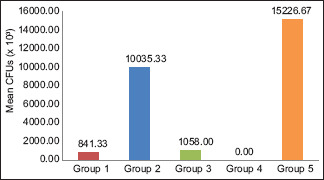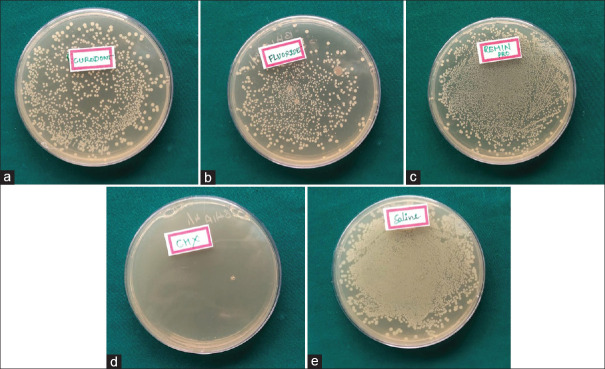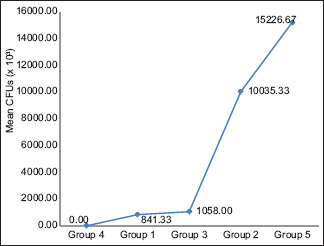基于氟化物和基于自组装肽P11-4的牙齿再矿化剂对变形链球菌抗菌效果的比较评价:微生物学研究。
IF 0.9
Q3 DENTISTRY, ORAL SURGERY & MEDICINE
Contemporary Clinical Dentistry
Pub Date : 2023-04-01
Epub Date: 2023-06-30
DOI:10.4103/ccd.ccd_631_21
引用次数: 0
摘要
背景:龋齿是一种与生物膜相关的口腔疾病,它继续折磨着世界上大多数人口。这种疾病是由被称为牙菌斑的生物膜中特定细菌和饮食成分之间的相互作用引起的。在致龋微生物中,变形链球菌(S.mutans)在致龋过程中起着关键作用。目的:评价和比较基于自组装肽P11-4的牙齿再矿化剂对变形链球菌的抗菌效果。材料和方法:体外微生物学研究。自组装肽P11-4凝胶(第1组)、氟增强羟基磷灰石凝胶(第2组)、酸化磷酸氟凝胶(第3组)、葡萄糖酸氯己定凝胶1.0%w/w(第4组;阳性对照)、,和生理盐水(第5组;阴性对照)在24小时内使用时间杀伤测定法进行,并计算变异链球菌集落形成单位(CFU)的数量。统计分析:使用Kruskal-Wallis检验和Mann-Whitney事后检验进行统计分析。结果:第一组平均CFU(×103)为841.33±3.51,第二组为10035.33±60.68,第三组为1058.00±56.96,第四组为0.00±0.00,第五组为15226.67±96.67。不同组的平均CFU(×103)差异有统计学意义,P<0.001。结论:基于自组装肽P11-4的牙齿再矿化剂对变形链球菌具有抑制作用,因此其应用可能影响致龋菌优势生物膜的形成。本文章由计算机程序翻译,如有差异,请以英文原文为准。



Comparative Evaluation of Antimicrobial Efficacy of Fluoride-Based and Self-Assembling Peptide P11-4-based Tooth Remineralization Agents on Streptococcus mutans: A Microbiological Study.
Background: Dental caries is a biofilm-related oral disease that continues to afflict the majority of the world's population. The disease results from an interaction between specific bacteria and dietary constituents within a biofilm known as dental plaque. Among the cariogenic microorganisms, Streptococcus mutans (S. mutans) plays pivotal role in caries-inducing processes. Objectives: Evaluate and compare the antimicrobial efficacy of self-assembling peptide P11-4-based tooth remineralization agents on S. mutans. Materials and Methods: An in vitro microbiological study. The antibacterial efficacy of self-assembling peptide P11-4 gel (Group 1), fluoride enhanced hydroxyapatite gel (Group 2), acidulated phosphate fluoride gel (Group 3), chlorhexidine gluconate gel 1.0% w/w (Group 4; positive control), and normal saline (Group 5; negative control) was performed using time-kill assay over a period of 24 h and the number of S. mutans colony-forming units (CFUs) were calculated. Statistical Analysis: Statistical analysis was done using Kruskal–Wallis test and Mann–Whitney post hoc Test. The level of significance was set at P < 0.05. Results: Group 1 showed mean CFUs (× 103) of 841.33 ± 3.51, Group 2 showed 10035.33 ± 60.68, Group 3 showed 1058.00 ± 56.96, Group 4 showed 0.00 ± 0.00, and Group 5 showed mean CFUs with 15226.67 ± 96.67. The difference in the mean CFUs (× 103) between different groups was statistically significant at P < 0.001. Conclusion: The self-assembling peptide P11-4-based tooth remineralization agent exhibited an inhibitory influence on S. mutans and hence formation of cariogenic bacteria dominant biofilm can thus be affected by its application.
求助全文
通过发布文献求助,成功后即可免费获取论文全文。
去求助
来源期刊

Contemporary Clinical Dentistry
DENTISTRY, ORAL SURGERY & MEDICINE-
CiteScore
1.50
自引率
0.00%
发文量
52
审稿时长
23 weeks
期刊介绍:
The journal Contemporary Clinical Dentistry (CCD) (Print ISSN: 0976-237X, E-ISSN:0976- 2361) is peer-reviewed journal published on behalf of Maharishi Markandeshwar University and issues are published quarterly in the last week of March, June, September and December. The Journal publishes Original research papers, clinical studies, case series strictly of clinical interest. Manuscripts are invited from all specialties of Dentistry i.e. Conservative dentistry and Endodontics, Dentofacial orthopedics and Orthodontics, Oral medicine and Radiology, Oral pathology, Oral surgery, Orodental diseases, Pediatric Dentistry, Periodontics, Clinical aspects of Public Health dentistry and Prosthodontics. Review articles are not accepted. Review, if published, will only be by invitation from eminent scholars and academicians of National and International repute in the field of Medical/Dental education.
 求助内容:
求助内容: 应助结果提醒方式:
应助结果提醒方式:


